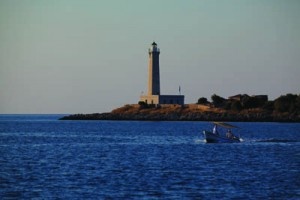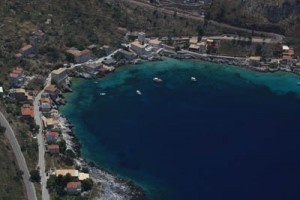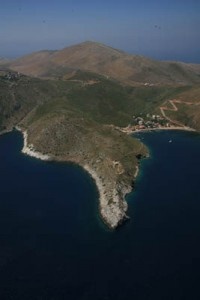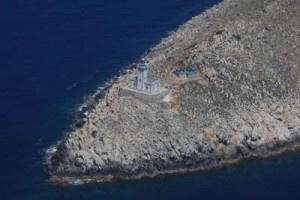On the Edge of the Sea – On the Waves of time…
Route description

This route starts from the port of Gytheio with a walk along the marble quay and another one to the island of Kranai, which is the second stop on your journey. On the eastern side of the island, you can see the 23-metre-high lighthouse built in 1873. Leave Gytheio, initially following the road to Areopolis. 4 km later you come to Limeni, which, in the past, was the base of the commercial activities of the powerful Mavromihalis family. Back to Areopolis, follow the provincial road towards Gerolimenas and then continue to your final destination, Porto Kayo and cape Tainaro, where the temple of Poseidon and the lighthouse that marks the most southernmost tip of mainland Europe are.
Information for visitors
The lighthouse in Kranai is closed for visitors as it is intended to host an exhibition dedicated to the maritime history of Mani. In Kranai you can also see the tower of the Tzanetaki family which, until recently, hosted the exhibition of the Historical and Ethnological Museum of Mani. If you attempt to follow the path that leads to the lighthouse of Tainaro make sure you have the appropriate equipment (sports shoes, a hat, water). Avoid hiking to the lighthouse at the hottest hours of summer days.
Recreation informationThis route covers a long distance from Gytheio to Tainaro. It is a route that offers a lot of experiences and is full of challenges… Start with fresh seafood lunch on the waterfront of Gytheio and continue your culinary trip to Oitylo and Limeni. Relax in the crystal-clear waters of the small port of Porto Kayo and at the Tainaro bay. Take some water with you and get ready for adventure. The wild beauty of Mani invites you to discover her secrets…
Lighthouses, ports and capes: landmarks and reference points for the experienced travellers from Mani, they are border land and, at the same time, sacred places, where the ancient altars and the churches of the new religion meet. From Kranai to Tainaro, the lighthouses are reference points and the ports, bases of pirates and freedom fighters of the past. They all welcome the visitor to the peninsula with open arms…
Point of Interest A
The Port of Gytheio

The port of Gytheio was an important centre of import and export trade in the first half of the 20th century. From here the products of Mani, oil, raisins, figs, acorns, cotton, prinokkokki, silk cocoons, cereals, tobacco, citrus and livestock products used to be traded. Exports were facilitated by the direct connection of the port of Gytheio with New York. Many of the locals followed the same route as the products: they, too, boarded the ocean liners and emigrated to the USA.
Point of interest B
Kranai Islet – The Lighthouse in Kranai

According to mythology, it was on the islet Kranai that Paris and Helen sought refuge before their departure for Troy. A breakwater connects the island to the city of Gytheio. On the eastern side of it is the 23-metre-high lighthouse built in 1873. During its first years, it operated with oil and sent out a beam of light that could be seen 15 nautical miles away.
Point of Interest C
Limeni

Limeni, the headquarters of the commercial activity of the Mavromihalis family, stands a short distance from Neo Oitylo and Karavostasi, north of Areopolis. Look for the Palace of Petronpeis Mavromihalis and also visit his first residence, the so-called “Syssitio”, which has been renovated and is now used as a guest house. You can see his statue near the church of Agios Sostis.
Point of Interest D
Porto Kayo

Pafsanias, the ancient Greek traveller, identifies Porto Kayo with ancient Psamathous. In recent times, the harbour of Porto Kayo, the name of which refers to the large number of quails that flock to the area, was a base of the fighter Lambros Katsonis.
Point of Interest E
Cape Tainaro – The Tainaro Lighthouse

The lighthouse of Tainaro was built in 1882 by French engineers and opened for the first time in 1887. It is 16 metres high and it is square-shaped as opposed to the octagon-shaped lighthouse of Kranai. It stopped operating during the years of the German occupation but resumed when the war ended. From 1950, when it was renovated for the second time, until 1984 three lighthouse keepers were employed in it.


